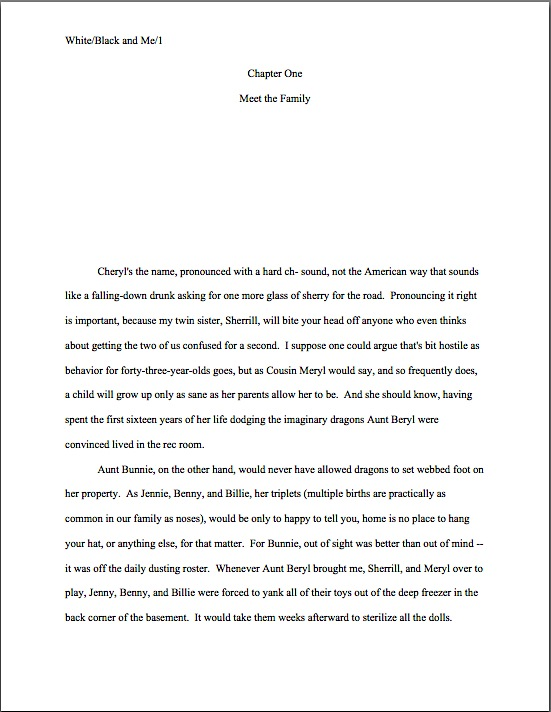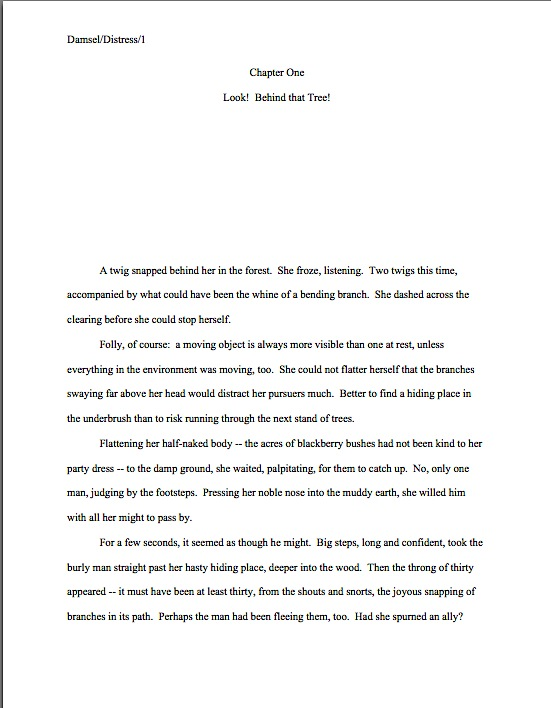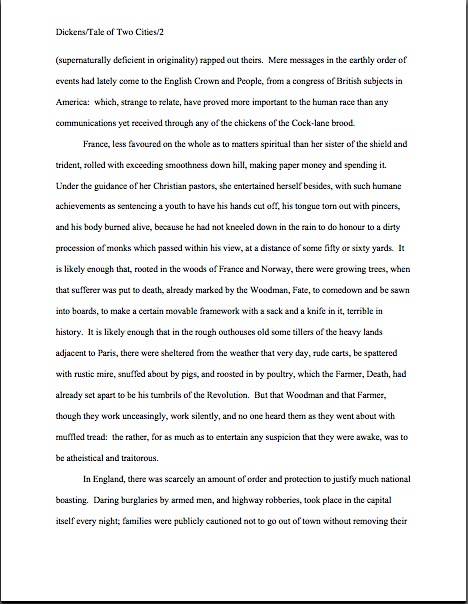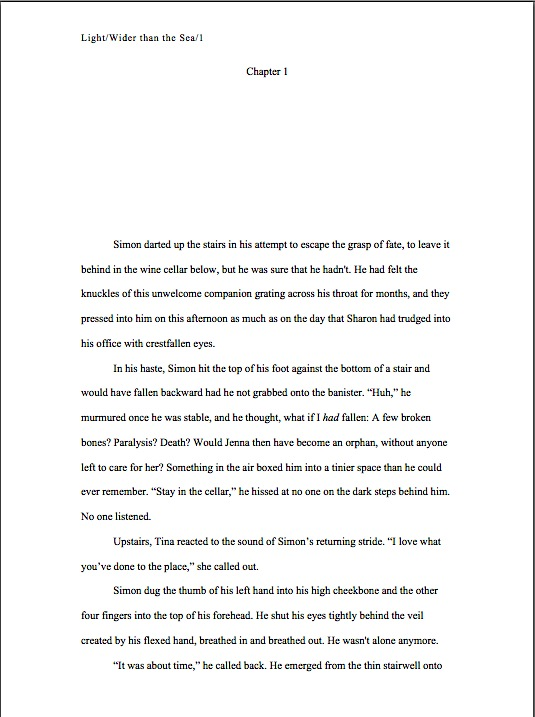Today, I had planned to launch headlong into my annual foray into how to construct a graceful and effective query letter, campers, but frankly, didn’t we devote an awful lot of the summer to discussing how to pitch? After so many weeks on end of dealing with practicalities, I feel that the artist in each of us deserves a little holiday.
So let’s refresh ourselves by talking craft for a while. Queryfest will be every bit as useful next week.
Memoir-writing and writing about reality as fiction has been much on my mind of late, and not merely because my memoir remains in publishing limbo. (Yes, still. Let’s just be grateful that not every memoirist’s extended family has the wherewithal to make credible $2 million dollar lawsuit threats.) While we writers talk endlessly amongst ourselves about craft and structure for fiction, it’s actually quite rare to stumble into a knot of literary conference attendees avidly discussing how to make a personal anecdote spring to life on the page.
Why is that, when it is so very hard to write memoir well? All too often, the prevailing wisdom dictates that all a writer needs to produce a successful memoir is an exciting life, an ability to write clearly, and, if at all possible, celebrity in another field, so the writing will matter even less. The writer’s platform and the inherent interest of the story, we’re told, are all that matter in a memoir. Anything beyond that, presumably, is gravy.
As to structure, that’s held to be self-evident. In the immortal words of Lewis Carroll,
The White Rabbit put on his spectacles. “Where shall I begin, please, your Majesty?” he asked.
“Begin at the beginning,” the King said gravely, “and go on till you come to the end: then stop.”
As a memoirist and an editor who works regularly with same, I must disagree. While a chronological structure can work, not all human events start out scintillating; depending upon the story, another structure might work better.
Then, too, a memoir cannot really be deemed a success unless readers find it entertaining, enlightening, or at the very least, interesting. That’s not merely a matter of story. Any long-form writing, be it fiction or nonfiction, will benefit from a strong narrative structure, a consistent, likable narrative voice, a plausible and engaging story arc, believable, well-drawn characters, a protagonist the reader would be happy to follow for a few hundred pages…
In short, many of the elements one might find in a well-constructed novel. But that’s not all that a good reality-based story requires, is it? After all, few readers will want to read a story, whether it is presented as memoir or as fiction, simply because it really happened. It needs to feel real on the page — and it needs to be enjoyable to read.
What makes me think that this might be news to many writers of memoir and reality-based fiction, you ask? For my sins, I have served quite frequently as a contest judge, assessing both memoir and novel entries, and I’m here to tell you, they look more similar on the page than one might think.
How so? They tend to share a few characteristics: a one-sided approach to scenes, as if the protagonist’s perspective were the only possible one; an apparent assumption that the reader will automatically side with the protagonist, regardless of what is going on, and bolstering both, a propensity for relating conflictual exchanges as though they were verbal anecdotes, light on detail but strong on emotion. Or, to boil all of these down to a single trait, these narratives tend to be disproportionately weighted toward a single point of view.
And memoirists’ hands fly heavenward all over the world. “But Anne,” they point out, and who could blame them? “My memoir is my story. Why wouldn’t it be biased toward my perspective?”
It should, of course — but in the interests of representing one’s own point of view, memoirists and writers of the real often render the narrative so one-sided that the situation neither seems plausible nor fairly presented. It just reads like a diatribe in scene form, a piece of prose whose primary point is not storytelling, but getting back at someone.
About half of you have started to blush, have you not? I’m not surprised; in both memoir and reality-based fiction, the scene where the reader is evidently expected to take the protagonist’s side, not because the antagonist is shown to be particularly awful, but because the narrative presents the antagonist without any sympathy — or, usually, any redeeming characteristics — is a notorious pet peeve of our old pal, Millicent the agency screener. And not just as a generality, either. When Millicents, their boss agents, and the editors to whom they cater gather to share mutual complaints in that bar that’s never more than 100 yards from any writers’ conference in North America, the annoying coworker stereotype often crops up in conversation.
As in, “You think you’re tired of conceptual repetition? I’ve read fourteen submissions this week alone with omitable annoying coworker scenes.”
It’s perhaps not altogether astonishing that memoirs would be rife with interactions between the protagonist/narrator and the people who happen to rile her, told in a breathlessly outraged tone, but aspiring writers of fact-based fiction are often stunned to discover that they were not the first to think of inserting actual conflicts into fictional stories. They shouldn’t be: there’s a pretty good reason that such scenes are ubiquitous in manuscript submissions and contest entries. Care to guess?
If you immediately cried out, “By gum, Anne, every writer currently crawling the crust of the earth has in fact had to work with someone less than pleasant at one time or another,” give yourself a gold star for the day. Given how often aspiring writers resent their day jobs — and, by extension, the people with whom they must interact there — that such unsavory souls would end up populating the pages of submissions follows as night the day.
If these charming souls appeared in novel and memoir submissions in vividly-drawn, fully fleshed-out glory, that actually might not be a problem. 99% of the time, however, the annoying co-worker is presented in exactly the same way as any other stereotype: without detail, under the apparent writerly assumption that what rankles the author will necessarily irk the reader.
Unfortunately, that’s seldom the case — it can take a lot of page space for a character to start to irritate a reader. So instead of having the character to demonstrate annoying traits and allowing the reader to draw his own conclusions, many a narrative will convey that a particular character is grating by telling the reader directly (“Georgette was grating”), providing the conclusion indirectly (through the subtle use of such phrases as, “Georgette had a grating voice that cut through my concentration like nails on a chalkboard”), or through the protagonist’s thoughts (“God, Georgette is grating!”)
Pardon my asking, but as a reader, I need to know: what about Georgette was so darned irritating? For that matter, what about her voice made it grating? It’s the writer’s job to show me, not tell me, right?
I cannot even begin to count the number of memoirs and novels I have edited that contained scenes where the reader is clearly supposed to be incensed at one of the characters, yet it is not at all apparent from the action of the scene why.
Invariably, when I have asked the authors about these scenes, the response is identical: “But it really happened that way!”
No surprise there. These scenes are pretty easy for professionals to spot, because the protagonist is ALWAYS presented as in the right for every instant of the scene, a state of grace quite unusual in real life. It doesn’t ring true.
The author is always quite astonished that his own take on the real-life scene did not translate into instantaneous sympathy in every conceivable reader. Ultimately, this is a point-of-view problem — the author is just too close to the material to be able to tell that the scene doesn’t read the way she anticipated.
Did I just see some antennae springing up out there? “Hey, wait a minute. Mightn’t an author’s maintaining objective distance from the material — in this case, the annoying co-worker — have helped nip this particular problem in the bud long before the manuscript landed on Millicent’s desk?”
Why, yes, now that you mention it, it would. Let’s look at the benefits of some objective distance in action.
Many writers assume, wrongly, that if someone is irritating in real life, and they reproduce the guy down to the last whisker follicle, he will be annoying on the page as well, but that is not necessarily true. Often, the author’s anger so spills into the account that the villain starts to appear maligned, from the reader’s perspective. If his presentation is too obviously biased, the reader may start to identify with him, and in the worst cases, actually take the villain’s side against the hero. I have read scenes where the case against the villain is so marked that most readers would decide that the hero is the impossible one, not the villain.
This character assassination has clearly not gone as planned. A little more objective distance might have made it go better. Who was it that said, revenge is a dish best served cold?
Yes, I called it revenge, because revenge it usually is. Most writers are very aware of the retributive powers of their work. As my beloved old mentor, the science fiction writer Philip K. Dick, was fond of saying, “Never screw over a living writer. They can always get back at you on the page.”
Oh, stop blushing. You didn’t honestly think that when you included that horrible co-worker in three scenes of your novel that you were doing her a FAVOR, did you?
My most vivid personal experience of this species of writerly vitriol was not as the author, thank goodness, but as the intended victim. And at the risk of having this story backfire on me, I’m going to tell you about it as nonfiction.
Call it a memoir excerpt. To prevent confusion, I’m going to offset the narrative from the discussion.
A few years before I began blogging, I was in residence at an artists’ colony. Now, retreats vary a great deal; mine have ranged from a fragrant month-long stay in a cedar cabin in far-northern Minnesota, where all of the writers were asked to remain silent until 4 p.m. each day to a sojourn in a medieval village in southwestern France to a let’s-revisit-the-early-1970s meat market, complete with hot tub, in the Sierra foothills.
A word to the wise: it pays to do your homework before you apply.
This particular colony had more or less taken over a small, rural New England town, so almost everyone I saw for the month of March was a writer, sculptor, photographer, or painter. While world-class painters and sculptors were imported up ice-covered rural roads every few days to critique and encourage those newer to their respective arts, the National Book Award winner scheduled to give feedback to the writers didn’t bother to show up for the first week of her residency. Amenities like kilns, darkrooms, and ladders to facilitate the construction of 20-foot woven cardboard cocoons seemed to appear whenever the visual artists so much as blinked. The writers, a tiny minority, had been shoved into a dank, dark cellar with cinder block walls; you could see the resentment flash in their eyes when they visited the painters’ massive, light-drenched studios, and compared them to the caves to which they had been assigned.
See what I just did there? I skewed the narrative so you would resent the visual artists.
But was that necessary? Objectively speaking, they were not the villains in this situation; they, like me, were visitors to the retreat. Besides, since the overwhelming majority of the Author! Author! community is made up of writers, couldn’t I simply have assumed that my readers would identify with the cave residents pretty much automatically?
Or, better yet, couldn’t I have included a vivid detail or two that would have nudged the reader in that direction without the narration’s appearing to be presenting a myopic account?
What kind of detail, you ask? Let’s try this one on for size.
Due to the musty dampness of the writers’ cellar, I elected to write in my assigned bedroom, in order to catch the occasional ray of sunlight. Sure, there were certain drawbacks — the desk had been designed for a hulking brute twice my size, while the desk chair had apparently been filched from a nearby kindergarten — but at least the heat worked. Too well, in fact: an hour and a half into my first afternoon of writing, a sleepy hornet emerged from the gaping hole around the charming antique light fixture and aimed straight for my head.
It was not the best moment to learn that the windows had been sealed for the winter. You know writers: we can’t be trusted not to let all of the heat out. Unlike, say, painters, whose windows might safely open onto vast vistas of forested hillside.
As the afternoon sun warmed the room, hornet after hornet emerged from its long winter’s nap. After the eighth had expressed its displeasure at my having had the temerity to have turned on either the light or the heat, I shook the bees off my jacket, wrapped my head and shoulders in several scarves, and plunged into a blizzard. By the time I reached the administration building, I was chilled to the bone.
Perhaps naïvely, I had assumed that the hornet’s nest in my room would come as a surprise to the retreat’s administrators. The writer who’d had the room the previous November — the local authorities had deemed it inadequately heated for winter residence — had complained about the bees, too. The painter-in-residence charged with rooting them out had simply not gotten around to it.
And didn’t for three days. He was too busy with a canvas that just couldn’t wait to be handed down to posterity. The administrators encouraged me to regard sleeping on a couch next to the dining hall as my contribution to the world’s supply of art. I had to wait until after dark in order to retrieve my laptop.
That engaged your sympathies more robustly, didn’t it? It’s still my experience and my perspective, told in my voice — but I’ve allowed you to draw the conclusion. That’s simply better storytelling.
Don’t see it? Okay, contrast the fleshed-out account above with the following series of summary statements.
Sharing meals in a dining hall was a bit high school-like, conducive to tensions about who would get to sit at the Living Legend in Residence’s table, squabbles between the writers and the painters about whether one should wait until after lunch to start drinking, or break out the bottles at breakfast (most of the writers were on the first-mentioned side, most of the painters on the latter), and the usual bickerings and flirtations, serious and otherwise, endemic to any group of people forced to spend time together whether or not they have a great deal in common.
An environment ripe, in other words, for people to start to find their co-residents annoying.
Aren’t you already longing for me to show you how specifically they were annoying, rather than merely telling you that they were? Let’s exacerbate the problem in the manner so many writers of the real do, creating the illusion of narrative distance by switching the text almost entirely into the passive voice.
Of course, such problems are endemic to large artists’ colonies. One classic means of dealing with the inevitable annoying co-resident problem is to bring a buddy or three along on a retreat; that way, if the writer in the next cubicle becomes too irritating, one has some back-up when one goes to demand that she stop snapping her gum every 27 seconds, for Pete’s sake. I am of the school of thought that retreating entails leaving the trappings and the personnel of my quotidian life behind, but there’s no denying that at a retreat of any size, there can be real value in having someone to whom to vent about that darned gum-popper. (Who taught her to blow bubbles? A horse?)
Doubtless for this reason, several artists had brought their significant others to the hornet-ridden New England village. Or, to be more accurate, these pairs had applied together: writer and photographer, painter and writer, etc. One of these pairs was a very talented young couple, she a writer brimming with potential, he a sculptor of great promise. Although every fiber of my being longs to use their real names, I shall not.
Let’s call them Hansel and Gretel, to remove all temptation.
And let’s see how this telling, not showing thing I’ve got going works for character development, shall we?
Hansel was an extremely friendly guy, always eager to have a spirited conversation on topics artistic, social, or his personal favorite, explicitly sexual. The dining hall’s Lothario, one constantly spotted him flirting with…hmm, let’s see how best to represent how he directed his attentions…everything with skin.
Amusing, but wouldn’t some details have brought his predilections more clearly before the reader’s eyes? Let’s try showing some of his work.
His eyes flickered over the female residents so persistently that I wondered if he was looking for a model. On day three, when he invited me to his palatial sculpture studio, I realized that he might have been seeking a lady to encase in plaster of Paris: practically every flat surface held representations of breasts, legs, pudenda, and breasts. He practically backed me into a backside. Murmuring some hasty excuse about needing to get back to my hornets, I slipped away from his grasping hands and dashed out into the pelting snow.
Still don’t see why that was better? Okay, let’s revert to generalities.
Being possessed of skin myself, I naturally came in for my fair share of Hansel’s attentions. (How’s that for a colorless summary of the proceeding story?) Generally speaking, though, I tend to reserve serious romantic intentions for…again, how to put this…people capable of talking about something other than themselves. Oh, and perhaps I’m shallow, but I harbor an absurd prejudice in favor of the attractive.
This is precisely the type of paragraph that will absolutely slay ‘em in a verbal anecdote, or even in a blog, but often falls flat on the page. Yes, it’s amusing; yes, people actually do speak this way, so it’s a plausible a first-person narrative voice. But it’s vague. It’s character development, in the sense that it purports to tell the reader something about the narrator, but the reader just has to take the narrative’s word for it. Is that really the best way to convince the reader what a protagonist is like?
An artists’ retreat tends to be a small community, however; one usually ends up faking friendliness with an annoying co-resident or two. Since there was no getting away from the guy — believe me, I tried — I listened to him with some amusement whenever we happened to sit at the same table. I was, after all, the only other artist in residence who had read any Henry Miller. We had coffee a couple of times when there was nobody else in the town’s only coffee shop. And then I went back to my room, battled away the wildlife, and wrote for 50 hours a week.
Imagine my surprise, then, when Gretel started fuming at me like a dragon over the salad bar. Apparently, she thought I was after her man.
Now, I don’t know anything about the internal workings of their marriage; perhaps they derived pleasure from manufacturing jealousy scenes. I don’t, but there’s just no polite way of saying, “HIM? Please; I do have standards” to an angry wife, is there? So I simply started sitting at a different table in the dining hall.
A little junior high schoolish? Yes, but better that than Gretel’s being miserable — and frankly, who needed the drama? I was there to write.
Let’s pause here to consider: what do you, the reader, actually know about Gretel at this point? Are your feelings about her based upon what you have actually seen her do or my conclusions about her motivations? And are the facts even clear: was I the only resident of whom Gretel was jealous, or did she fume over the salad bar with anyone possessing two X chromosomes?
Wouldn’t it have worked better had I just shown her slapping peanut butter violently onto some white bread while I tried to make pleasant conversation with her, or depicted her veering away from me with her cracked metal tray? In short, wouldn’t it have made more sense to show this as a scene, rather than telling it as an anecdote?
Often, this fix is expressed rather confusingly: writers are told to insert some narrative distance into such scenes. I’m not a big fan of this language, for the simple reason that most memoirists and writers of the real new to editor-speak tend to interpret it as a call to make the narrative appear objective by, you guessed it, retreating into the passive voice. Let’s take a gander at this strategy in action.
Another phenomenon that often characterizes a mixed residency — i.e., one where different types of artists cohabitate — is a requirement to share one’s work-in-progress. At this particular retreat, painters and sculptors had to fling their studios open to public scrutiny once a week. Each writer had to do at least one public reading in the course of the month.
Feels like you’ve been shoved back from the story, doesn’t it? That’s how verbal anecdotes tend to read on the page: as rather vague summaries. When they are in the passive voice as well, the narrator can come across as the passive puppet of circumstances, rather than as the primary actor of the piece, the person who makes things happen.
Let’s borrow a tool from the novelist’s kit and make the protagonist active, shall we?
Being a “Hey – I’ve got a barn, and you’ve got costumes!” sort of person, I organized other, informal readings as well, so we writers could benefit from feedback and hearing one another’s work. I invited Gretel to each of these shindigs; she never came. By the end of the second week, my only contact with her was being on the receiving end of homicidal stares in the dining hall, as if I’d poisoned her cat or something.
It was almost enough to make me wish that I had flirted with her mostly unattractive husband.
But I was writing twelve hours a day (yes, Virginia, there IS a good reason to go on a retreat!), so I didn’t think about it much. I had made friends at the retreat, my work was going well, and if Gretel didn’t like me, well, we wouldn’t do our laundry at the same time. (You have to do your own laundry at every artists’ retreat on earth; don’t harbor any fantasies about that.) My friends teased me a little about being such a femme fatale that I didn’t even need to do anything but eat a sandwich near the couple to spark a fit of jealous pique, but that was it.
Aha, so Gretel had singled me out. Was there a good narrative reason not to make that plain earlier? It almost certainly would have been funnier — and made both my reactions and my conclusions as narrator make more sense to the reader.
At the end of the third week of our residency, it was Gretel’s turn to give her formal reading to the entire population of the colony, a few local residents who wandered in because there was nothing else to do in town, and National Book Award winner who had finally deigned dropped by (in exchange for a hefty honorarium) to shed the effulgence of her decades of success upon the resident writers. Since it was such a critical audience, most of the writers elected to read highly polished work, short stories they had already published, excerpts from novels long on the shelves. Unlike my more congenial, small reading groups, it wasn’t an atmosphere conducive to experimentation.
Wow, I’ve left you to fill in a lot of details here, have I not? How could you possibly, when the narrative so far has given you only a very sketchy view of time, place, and character?
Four writers were scheduled to read that night. The first two shared beautifully varnished work, safe stuff, clearly written long before they’d arrived at the retreat. Then Gretel stood up and announced that she was going to read two short pieces she had written here at the colony. She glanced over at me venomously, and my guts told me there was going to be trouble.
See how I worked in the false suspense there? Rather than showing precisely what her venomous glance was like — impossible for you to picture, right, since I have yet to tell you what she looks like? — I embraced the ever-popular storytelling shortcut of having the protagonist’s reaction to an event or person take the place of showing what was actually going on. Think that was the best strategy for this story?
Let’s try another tack. How about getting a little closer to what’s happening in that crowded room, so the reader may feel more like she is there? Or at least more like she’s standing in the narrator’s shoes?
Gretel settled a much-abused spiral notebook onto the podium and began to read a lengthy interior monologue in stentorian tones. Her eyes never left the paper, and with good reason: the plotless account depicted Hansel and Gretel — both mentioned by name on page 1, incidentally — having sex in vivid detail. Just sex, without any emotional content to the interaction, in terms neither titillating nor instructive. It was simply a straightforward account of a mechanical act, structured within a literal countdown to the final climax: “Ten…nine…eight…”
It was so like a late-1960’s journalistic account of a rocket launching that I kept expecting her to say, “Houston, we’ve got a problem.”
I cringed for her — honestly, I did. I’d read some of Gretel’s other work: she was a better writer than this. So what point was she trying to make by reading this…how shall I put it?…a literarily uninteresting piece whose primary point seemed to be to inform the uncomfortable audience that she and her husband had consummated their marriage?
See how I used my response to develop the narrator’s character? Memoirists and writers of the real too often forget that the narrator is the protagonist of the story they are telling, and thus needs to be fleshed out as a character. If I’d attacked that last paragraph with a big more descriptive vim, I might have worked in some interesting insights into both Gretel and Hansel’s characters — how did her account jibe with his sculptural depictions of the act, for instance?
Oh, you thought that all of those body parts were languishing around his studio solo? Alas, no; I’ve seen less accurate models in biology classes. Again, wouldn’t it have been more effective storytelling to have shown that — or even made that last comment — while the protagonist was in the studio?
That would also have been the natural time to work in that Hansel’s sculptures did not…again, how to put this tactfully?…appear to have been based upon his wife’s womanly attributes. Artistically, he favored curves; she was so angular that she could have cut vegetables on her hip bones.
Lingering too long in the narrator’s head can be distracting from the action, though. Throughout the next paragraph, I invite you to consider: as a reader, would you have preferred to see the action more directly, or entirely through the narrator’s perspective?
Maybe I just wasn’t the right audience for her piece: the painters in the back row, the ones who had been drinking since breakfast, waved their bottles, hooting and hollering. They seemed not to notice that although the monologue was from a female perspective, there were no references whatsoever to the narrator’s physical sensations, only what Hansel was doing. The part of Gretel might have been quite adequately played by a robot.
Call me judgmental, but I tend to think that when half the participants seem to be counting the seconds until the act is over, it’s not the best romantic coupling imaginable. Still, looking around the auditorium, I didn’t seem to be the only auditor relieved when it ended. “Three…two…one.” No one applauded but Hansel.
In first-person pieces, the narration will often switch abruptly from inside the protagonist’s head to an ostensibly objective set of descriptions. Sometimes it works, sometimes it doesn’t. You be the judge: how well do you think the next paragraph carries the story forward from the last?
Gretel’s second piece took place at a wedding reception. Again, it was written in the first person, again with herself and her husband identified by name, again an interior monologue. However, this had some legitimately comic moments in the course of the first few paragraphs. As I said, Gretel could write.
Somewhere in the middle of page 2, a new character entered the scene, sat down at a table, picked up a sandwich — and suddenly, the interior monologue shifted from a gently amused description of a social event to a jealously-inflamed tirade that included the immortal lines, “Keep away from my husband, {expletive deleted}!” and “Are those real?”
Need I even mention that her physical description of the object of these jabs would have enabled anyone within the sound of her voice to pick me out of a police line-up?
Wouldn’t it have been both more interesting and better character development to have shown the opening of Gretel’s second piece, rather than leaving it to the reader’s imagination? Ponder how that choice might have affected your perception of whether this scene is funny or tragic, please, as the narrative belatedly tells what it should have shown in the previous section.
She read it extremely well; her voice, her entire demeanor altered, like a hissing cat, arching her back in preparation for a fight. Fury looked great on her. From a literary standpoint, though, the piece fell flat: the character that everyone in the room knew perfectly well was me never actually said or did anything seductive at all; her mere presence was enough to spark almost incoherent rage in the narrator. While that might have been interesting as a dramatic device, Gretel hadn’t done enough character development for either “Jan”– cleverly disguised name, eh?– for the reader either to sympathize with the former or find the latter threatening in any way.
There was no ending to the story. She just stopped, worn out from passion. And Hansel sat there, purple-faced, avoiding the eyes of his sculptor friends, until she finished.
The first comment from the audience was, “Why did the narrator hate Jan so much? What had she done to the narrator?”
Had I been telling this anecdote verbally — and believe me, I have — this spate of summary statements and analysis of what the reader has not been shown might well work beautifully. Memoirists tend to be fond of paragraphs like this, commenting upon the action as if the reader had also been there. It makes abundant sense, from the writer’s perspective: after all, I was actually there, right?
But talking about events creates a very different impression on the page than writing about them vividly enough that the reader can picture the action and characters for herself. If I had shown you the story Gretel was reading, at least in part, you could have judged this character based on her own words — much more powerful than the narrator’s simply telling you what you should think about her.
A professional reader like Millicent — or, heck, like me — might well raise another objection to that last section: since the narration is so skewed to the protagonist’s side, some readers may feel that this account lacks credibility. Could Gretel actually have been as vitriolic (or unstrategic) as I’ve depicted her here?
Actually, she was, every bit — but does that matter, if the narrative can’t make her seem plausible on the page? The fact that Gretel existed and that she chose to act in this extraordinary manner is not sufficient justification for the reader to finish this story. It also has to work as a story, and that’s going to require some serious character development for not only the narrator, but the other characters as well.
You’d be astonished at how often memoir submissions do not treat either as characters. Frequently, Millicent sees memoirs — and slice-of-life fiction, for that matter — that are simply commentary upon what was going on around the protagonist. Yet a memoir isn’t a transcript of events, interesting to the reader simply because they happened to the narrator; it’s one person’s story, skillfully pruned to leave out the dull parts. If the reader doesn’t get to know that narrator, though, or come to experience the other characters as real, the memoir is likely to fall flat.
Why? Because it will read like a series of anecdotes, rather than like a book.
Fictionalizers of real life tend to have an easier time thinking of their protagonists as protagonists, I notice, but as any Millicent could tell you, they often give away the narrative’s bias by clearly siding with one character over another. Or by depicting one character as all sweetness and light and the other as all evil. A popular secondary strategy: describing other characters’ reactions to the antagonist as universally in line with the protagonist’s, as though any onlooker would have had exactly the same response.
I was very nice to Gretel afterward; what else could I do? I laughed at her in-text jokes whenever it was remotely possible, congratulated her warmly on her vibrant dialogue in front of the National Book Award nominee, and made a point of passing along a book of Dorothy Parker short stories to her the next day.
Others were not so kind, either to her or to Hansel. The more considerate ones merely laughed at them behind their backs. (“Three…two…one.”) Others depicted her in cartoon form, or acted out her performance; someone even wrote a parody of her piece and passed it around.
True, I did have to live for the next week with the nickname Mata Hari, but compared to being known as the writer whose act of fictional revenge had so badly belly flopped, I wouldn’t have cared if everyone had called me Lizzie Borden. And, of course, it became quite apparent that every time I went out of my way to be courteous to Gretel after that, every time I smiled at her in a hallway when others wouldn’t, I was only pouring salt on her wounded ego.
Is there anything more stinging than someone you hate feeling sorry for you?
At last, we come full circle, back to my original point in sharing this anecdote in the first place: if your answer was any flavor of yes, you might want to consider waiting until you’ve developed some objective distance from your annoying co-worker before committing her to print. Think at least twice about what you’re putting on the page, particularly for work you are submitting to contests, agencies, or small presses.
Or, heaven forbid, reading to a group of people you want to like you. Or your narrator.
If you’re still angry, maybe it’s not the right time to write about it for publication. Your journal, fine. But until you have gained some perspective — at least enough to perform some legitimate character development for that person you hate — consider giving it a rest. Otherwise, your readers’ sympathies may ricochet, and move in directions that you may not like.
It’s always a good idea to get objective feedback on anything you write before you loose it on the world, but if you incorporate painful real-life scenes into your fiction, sharing before promotion becomes ABSOLUTELY IMPERATIVE. If you work out your aggressions at your computer — and, let’s face it, a lot of us do — please seriously consider joining a writing group. To be blunt about it, finding good first readers you can trust can save you from looking like an irate junior high schooler on a rampage.
And Gretel, honey, in the unlikely event that you ever read this, you might want to remember: revenge is a dish best served cold. Or, as Philip used to say, never screw over a living writer. You never know who might end up writing a blog.
Hey, I’m only human — which renders me a more interesting protagonist in a memoir, right? As a memoirist, I have to assume that my readers too intelligent to believe that I was 100% perfect in this trying situation (I must admit, I did make an unkind joke or two in private), or that Gretel was 100% nasty (in actuality, she was rather nice to people her husband did not appear to be obsessed with sculpting), I suspect that most readers would also wonder whether Hansel actually stood by passively while his wife seethed with jealousy (he didn’t: he egged her on, in what appeared to me to be characteristic of their relationship). Were I planning to use this dynamic in a memoir, it would be in the story’s best interest to develop those less-neat elements into a more plausibly complete account.
If I hoped to fold this frankly pretty darned annoying incident into a novel, the imperative to flesh these people out into fully-rounded characters would be even stronger. Showing their foibles through action and dialogue, rather than just telling the reader what conclusions to draw, is not only better storytelling — it’s less intrusive narration.
Would I feel as vindicated? Perhaps not. Enough time has passed, however, that I now see this story as fundamentally sad: instead of befriending a more experienced writer who could have conceivably helped her on the long, twisty road to publication, Gretel allowed the troubled dynamic of her marriage to become the central focus of a bunch of not-particularly-sympathetic strangers. She, too, was in that dank basement, while her husband created his fantasies of women who did not resemble her in comparative comfort. If he hadn’t chosen me to as the prod with which to keep poking her insecurities, I’m sure he would have found somebody else.
So who is the actual villain of this piece? You decide; that’s the reader’s job, after all.
Keep up the good work!


































